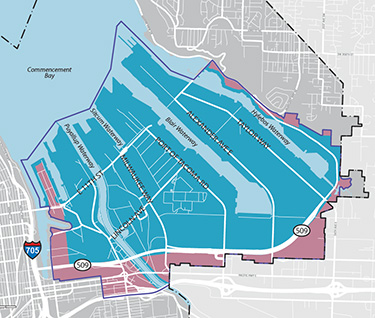|
Subscribe / Renew |
|
|
Contact Us |
|
| ► Subscribe to our Free Weekly Newsletter | |
| home | Welcome, sign in or click here to subscribe. | login |
Real Estate
| |
September 5, 2017
As more housing gets built, Tacoma takes a closer look at tideflats area
Journal Staff Reporter
Tacoma has traditionally been an industrial city, but as more people move there and housing demand grows, some industrial projects are running into conflicts with the neighbors.
So the city is considering interim regulations that would prohibit certain new industrial uses and some housing development while it devises a Tideflats Subarea Plan to cover the industrial areas and adjacent neighborhoods.
The city, Port of Tacoma and the Puyallup Tribe of Indians are developing an interlocal agreement to fund the plan.
The Planning and Development Services Department will hold a meeting on the proposed interim regulations at 5 p.m. tomorrow in the Tacoma Municipal Building at 747 Market St. The Planning Commission will hold a public hearing on them at 6 p.m. Sept. 13 at the Greater Tacoma Convention Center, 1500 Commerce St.
The regulations would prohibit certain new industrial uses in the port's Manufacturing/Industrial Center in the Tacoma Tideflats area, which generally stretches from East D Street to Marine View Drive, and in other heavy industrial areas city-wide.
Those uses include coal terminals and coal bulk storage facilities; oil or other liquefied or gaseous fossil fuel terminals, bulk storage, manufacturing, production, processing or refining; chemical bulk storage, production, processing, and acid manufacturing; smelting; and mining and quarrying.
The regulations also would prohibit new residential units and platting along the slopes above Marine View Drive, and expand public notification for heavy industrial uses city-wide that require discretionary permits or SEPA environmental review.
Tacoma Senior Planner Stephen Atkinson said the City Council is expected to consider them in late October or November. If approved, they must be reauthorized every six months, or they expire, but the intention is to keep them in place until the subarea plan is completed, likely in about two years.
Atkinson said people are moving to Tacoma for more affordable housing, an urban setting, historic housing and Sounder train service to Seattle. This growth is driving more retail and commercial activity in Tacoma, and he said city officials are trying to create places with housing, services, transit and jobs.
The subarea plan would look at the desired transitions between heavy industrial uses and neighborhoods, and whether land use should be changed to mitigate impacts and provide better separation, Atkinson said. The plan would also recommend transportation projects to stimulate development in the tideflats, and consider environmental review for different development scenarios.
The city must balance the charge by the Puget Sound Regional Council and the state to expand its industrial base and accommodate residents. Atkinson said about 127,000 new residents are expected by 2040 — about half of them downtown.
PSRC's Vision 2040 growth strategy requires Tacoma to develop a subarea plan to help get funding for transportation projects to expand the industrial base, and aid emergency response, Atkinson said.
He said 10,000 people work in the port's manufacturing center and another 7,000 to 10,000 jobs are expected there in the next 20 to 30 years. “It's a very important industry” that brings good jobs, he said.
The subarea plan also reflects a desire to grapple with climate change, and public concerns over proposed development in the port's manufacturing center, Atkinson said. Those projects include a methanol plant and a Puget Sound Energy liquefied natural gas facility.
About 1,000 people turned out at a meeting on the methanol plant, which did not move forward, but PSE's project is under construction, he said.
Legacy pollution in Tacoma's industrial areas is also driving reexamination of land use regulations, Atkinson said. Public attitudes have changed from “anything goes,” especially as more housing is built nearby, he said.
Atkinson said there are housing projects along Foss Waterway downtown that are close to oil and gas storage facilities, and two other areas that abut the port's manufacturing center are also getting new housing: northeast Tacoma and near the Tacoma Dome, where more transit oriented development is getting built.
Zoning in industrial areas has been “permissive” in the past, he said, and does not specify what risks or impacts should be allowed. “We need to start developing a more refined approach in the kinds of industrial uses we're trying to attract and grow the industrial land base,” he said.
He said people have asked — somewhat in jest — whether a nuclear power plant would be allowed along Marine View Drive.
Comments on the interim regulations may be submitted to Planning Commission, 747 Market St., Room 345, Tacoma, WA 98402, via fax at (253) 591-5433, or by email at planning@cityoftacoma.org. The proposal is at cityoftacoma.org/tideflatsinterim.
Lynn Porter can be
reached by email or by phone
at (206) 622-8272.



